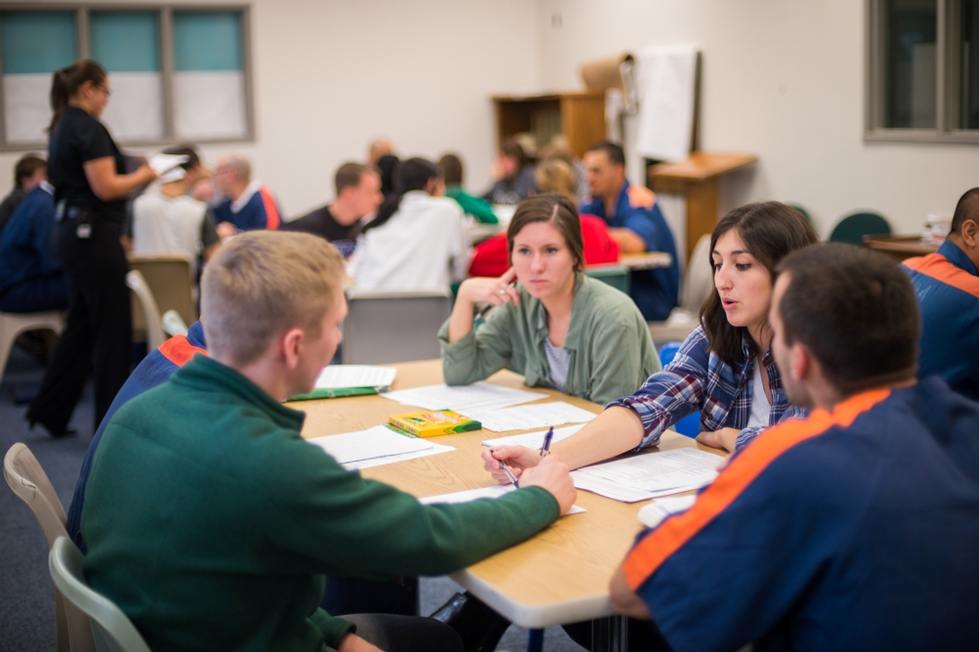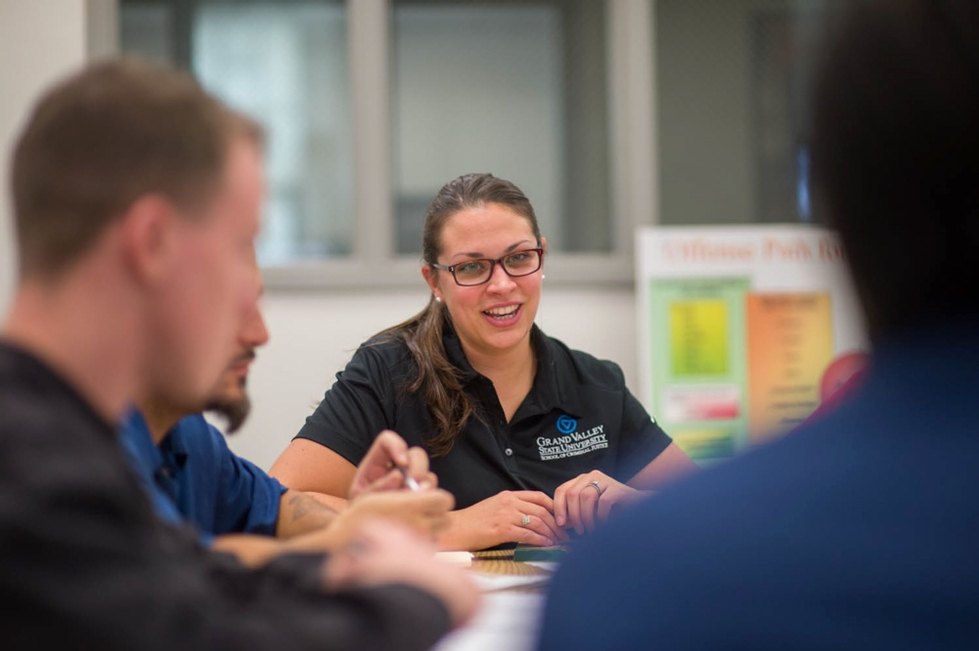Inside out
Students, prison inmates learn side-by-side
Searched, patted down, led through a metal detector and stamped as cleared to enter — that was the process required before students could walk into Jacquelynn Doyon-Martin’s class each week last fall. They met inside the oldest functioning prison in the state: the Michigan Reformatory in Ionia.
The course is part of the Inside-Out Program offered each fall, which accepts 15 Grand Valley students and 15 inmates at the reformatory, who must apply to attend.
During the three-hour class, taught by Doyon-Martin, assistant professor of criminal justice, students tackled subjects like criminological theory, prison culture and victimization.
“I was nervous at first. I didn’t know what to expect,” said Chad Jackson, a junior from Brown City majoring in criminal justice and psychology. “It was intimidating the first few times entering the prison, but then it became routine.”
Grand Valley students in the program are referred to as “outside-students” and the inmates are referred to as “inside-students.” Outside-students are only known by their first names and inside-students are only known by their last names.

Grand Valley students and inmates at the Michigan Reformatory meet weekly for a criminal justice class.
photos by Mitch Ranger
The offenses of the inside-students, which range from drug convictions to felony murder, are not known to others; the class is not open to people convicted of criminal sexual conduct, Doyon-Martin said. Grand Valley students earn course credit and inside-students receive a certificate of completion that is placed in their file and can be seen by parole boards.
Doyon-Martin said in order to understand the purpose of the course, it is important to know what it is not. “This isn’t a scared straight program. We are not there to do research, charity work or volunteer work,” she said. “We are not there to expose what is wrong with the prison. This is a college class, which just happens to take place in a prison.”
Mark Allen, a senior from Middleville majoring in criminal justice, said he got over being nervous very quickly.
“I was surprised that by the second time we met, I felt just like all my other classmates,” Allen said. “I was shocked to learn the inside-students were very nervous to meet us. They were afraid we would judge them.”
Doyon-Martin said she makes it clear that everyone is a student, not an inmate or convict. “We sit in a circle to eliminate a feeling of hierarchy or control. This also helps to allow for more open dialogue,” she said.
Typically, there is more dialogue between students than lectures from the instructor. Lively discussions for this particular course included topics on restorative justice, victimization and the underlying causes that might lead to a life of criminal activity.
“I learned valuable insights and viewpoints from the inside-students,” said Taylor Greiner, a senior from Grand Haven who wants to work in corrections. “People from different backgrounds will have different opinions. I learned that many who commit crimes tend to have histories of victimization.”
Students said while there may have been disagreements, there were not any arguments and class members were allowed to explain their viewpoints. They described their experience as transformative.
“A textbook can’t give you the emotional aspects of prison life and you only get the author’s perspective,” said Allen. “Some classmates shared their personal stories — the reality of prison life. It’s much different than what is depicted on television or in the movies.”
National statistics show 90 percent of inmates are released and 70 percent will end up back in prison. Doyon-Martin said part of the reason is a lack of opportunities for inmates to improve themselves while incarcerated.

Jacquelynn Doyon-Martin, assistant professor of criminal justice
“The greater benefit of this program for inside-students is that they are able to interact with the community,” she said. “Our entire prison system is so separated and isolated. We send folks away for extended periods of time, completely disconnecting them from society, and once released, they are expected to immediately jump back in.”
Grand Valley was one of the first universities in the state to offer the Inside-Out Program; the course was first taught by Carly Hilinski-Rosick in 2010. The program is now offered in more than 37 states with more than 500 trained instructors.
“It is easy to forget prisoners are real people; they are a forgotten population,” said Greiner. “I learned to be less judgmental, which will serve me well when working in the criminal justice field.”
Jackson said it was an emotional goodbye when the semester ended. Both inside- and outside-students signed a contract agreeing not to contact one another.
“When we left, the inside-students told us that we are the future,” said Jackson. “They talked about rehabilitation and how they might fit back in society. They said they are hopeful for their futures.”
